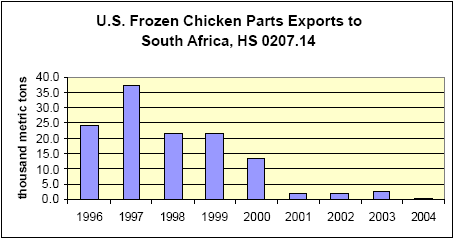



International Egg and Poultry Review
By the USDA's Agricultural Marketing Service - This is a weekly report looking at international developments concerning the poultry industry, this week looking at South Africa and WTO Agriculture Negotiations.
South Africa
On April 28, 2005, South Africa lifted the restrictions on most poultry
imports from the U.S. The only remaining ineligible products are poultry
trimmings, mince, mechanically recovered poultry meat and other
anatomically unrecognizable cuts. South Africa had banned imports of
raw poultry from the U.S. in February 2004, due to the detection of
disease in the U.S.

South Africa imposed provisional anti-dumping duties on U.S. chicken
parts (HS 0207.14 and 1602.32) in July 2000, after an investigation
following a complaint by the South African poultry industry in 1999. The
anti-dumping duties were reaffirmed in December 2000. The duties
ranged from 209 percent to 357 percent.
The General Agreement on Tariffs and Trade (GATT) allows members
to take a safeguard action to protect a specific domestic industry. Under
the Uruguay Round of Agreements Act, approved in late 1994, antidumping
measures are valid for five years and then must be reviewed.
The sunset review determines whether revoking the order would be
likely to lead to continuation or recurrence of dumping. If dumping is
likely to resume, the anti-dumping duties can be extended for another
three years.

Source: U.S. Trade Representative; U.S. International Trade Commission; South Africa International Trade Commission; U.S. International Trade Administration; USDA: Food Safety Inspection Service, Foreign Agricultural Service; FAO; news wires.
Mexico: Poultry Sector Creating A New Export Program
The Mexican Poultry Producers Association (UNA) held its 43rd Ordinary
General Assembly on April 25-26, where the new President of UNA,
Justo Lopez Hernandez, was introduced. Cesar de Anda, the outgoing
President, announced the creation of an export program between UNA
and the government.
The Secretariats of Economy and Agriculture
signed an agreement with UNA during the event to create a
competitiveness program (Aviexporta) for the poultry sector to prioritize
the tasks necessary to consolidate and foster a major presence in the
international market for this sector. According to de Anda, the program
intends to increase exports by 25 percent within the next ten years and
create 500,000 additional jobs. It was also announced that Mexico is
working jointly with the United States and other countries to consolidate
a World Poultry Organization.
Source: USDA/FAS Attache Report
WTO Agriculture Negotiations
The Doha free trade round, which aims to lower barriers to global
commerce, was supposed to be concluded in 2004. Disagreements
over subsidies and protected markets presented major obstacles which
have stalled talks. In Geneva, the WTO agriculture talks had been
suspended on April 19, 2005 after discussions came to an impasse.
On May 4, 2005 ministers from about 30 countries continued talks in
Paris. Trade ministers finally made a breakthrough on agriculture
technicalities. Now the agreement must go to Geneva for formal
confirmation by the full WTO, a group of 148 countries.
The agreement is a compromise between the EU and Brazil, leader of
the Group of 20 (which includes major developing countries such as
Brazil, India and South Africa). The dispute centered on the way that flatrate
import duties should be converted into percentage tariffs, based
on the value of the goods. Doha guidelines state that higher tariffs will
get bigger cuts, so EU negotiators held out for lower percentages to
limit European farmers' exposure to foreign competition as a result of
the trade round.
Agricultural tariffs are based on quantities imported into ‘ad valorem’
equivalents (AVEs), i.e., tariffs based upon the price of the product.
Ad valorem duties are in terms of the percentage value of the commodity
and non-ad valorem or specific tariffs are per-unit based, such as
dollars per kilogram.
AVE conversion has pitted the EU and G-10 countries (Japan, South
Korea, Switzerland and other major importing countries) against the
US, the Cairns Group of agricultural exporters and the G-20. The former
groups make use of a large number of specific tariffs; these need to be
converted to AVEs in order for countries to proceed with their work on
the tiered tariff reduction formula (under which higher tariffs will be
reduced more steeply). The G-20 group insisted on a tight formula for
conversion while the EU insisted on flexibility in determining the
methodology to be used.
Source: Bridges Weekly Trade News Digest, news wires.
To view the full report, including tables please click here
Source: USDA's Agricultural Marketing Service - 10th May 2005








